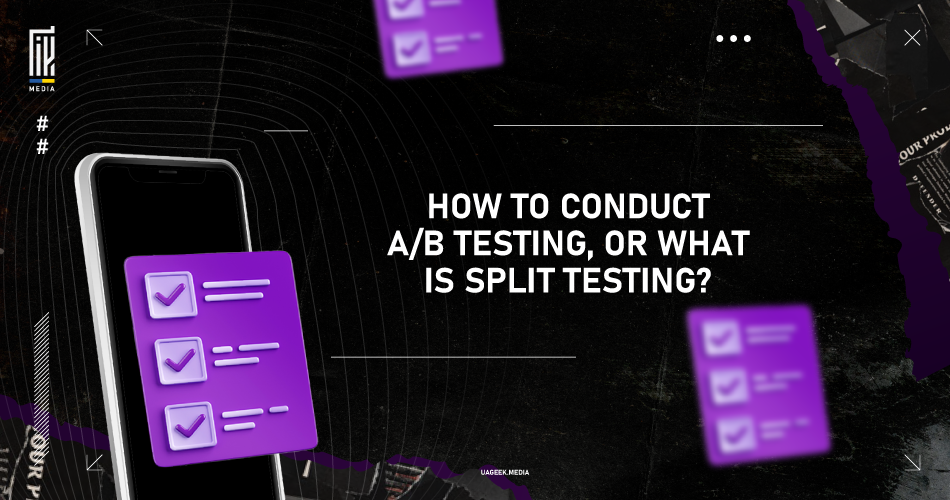Welcome, community! In pursuit of high conversion, arbitrageurs often start experimenting: from changing creatives to even changing ad networks. But how do you feel about completely legal experiments on the target audience itself? Because today’s discussion will be precisely about this.
Before we start our material, we want to suggest you familiarize yourself with another article – HOW TO POUR FREE TRAFFIC FROM FB IN 2024: A STEP-BY-STEP GUIDE. Thank you for your attention!
What is A/B Testing?
A/B testing (or split test) is a type of research aimed at discovering the audience’s reaction to certain small changes to a product. This product can be anything, but today we’ll talk specifically about landing pages.
It works very simply. There’s a website. It has a traditional menu. You make a copy of the site that exists alongside the main version, where you transform this menu from vertical to horizontal. Then you see how this affected user behavior: whether the number of clicks on the menu increased or decreased. You draw conclusions and then decide whether to make those changes to the website in general.
In the case of landing pages, arbitrageurs experiment with the placement of forms and buttons, colors, etc. The main thing is to make minor changes to better understand whether that element affects the conversion or whether to look for other reasons for the lack of conversion.
Among the key elements experimented with during A/B testing, we can highlight:
- Texts, headlines. You can test which of two trigger headlines will show better efficiency. This is relevant not only for landing pages but also for regular creatives.
- Graphics, videos, audio, animation. A vast amount of work is needed here because there are traditionally a lot of creatives for each offer. Finding the most effective one is extremely difficult. But thanks to split testing, you have the opportunity to assess their impact on conversion, finding the one that sells the best.
- Reviews. Reviews can either help conversion or lower it. Even the best reviews can negatively impact conversion, as all “I’m thrilled with this casino, I only win here!” sounds quite suspicious. Therefore, experiments on reviews are also an effective method of split testing.
But in practice, even those elements that at first glance do not affect conversion can actually impact traffic, either deterring it or stimulating it. Therefore, it is necessary to analyze which key elements are present on the landing page and then conduct testing.
When is it Necessary to Conduct a Split Test?
A/B testing is a necessary procedure for almost everyone involved in affiliate marketing: from arbitrageurs to SEO specialists and webmasters. There’s no difference because this research method is universal, suitable for testing website efficiency and checking the viability of creatives.
The main sign that you need to conduct A/B testing is an increase in the bounce rate on your site or landing page. But in reality, that’s like fighting a fire with a can of gasoline. It’s best to conduct split testing regularly, monitoring how it positively or negatively affects behavior factors, including conversion.
How to Conduct A/B Testing?
The algorithm for conducting A/B testing is quite simple.
First, choose the element that will be the subject of our study. The most important thing is to choose only one thing: a headline, banner, background, etc. This will allow you to get the most accurate results.
Second, set a goal. The goal can be to increase conversion, clicks, views, etc. This way, we choose, practically, the metric we will focus on during A/B testing.
Preparation – gather current statistics to be able to make a comprehensive and objective analysis of how the changes have affected the audience.
Third, create a version of the website where changes will be made. If it’s about creatives – then prepare them beforehand.
Fourth, choose how we will conduct the testing. For a landing page, you can use Crazyegg, whose standard subscription costs $49 per month. If you’re looking for something free, try Google Marketing Platform. There, you only need a Google Analytics account.
Set up the testing parameters: who will see the modified landing, how often, etc. It should be noted that what parameters you can choose directly depends on the testing service you use.
Fifth, finally, collect data and analyze it, compare it with the previous performance indicators of the page, and choose the one that performed the best. If you are not satisfied with the result, you can repeat the procedure, choosing another element for the study.
Conclusion
Overall, split testing is an entirely achievable research method. However, it is really effective if you conduct everything correctly. That means not changing several elements during testing, being guided by your target audience rather than general rules from various cases, setting up the test correctly, etc.
Also, it’s important to correctly calculate the traffic flow and even the testing terms. Traditionally, it lasts no less than two weeks if we’re talking about landing pages. For creatives, these terms are much shorter, and effective A/B testing can be conducted over a few days.
Do you resort to A/B testing? And how much does it affect the conversion in your projects? Come to our Telegram community and share your own opinion!
With respect, Your Geek!


Comments